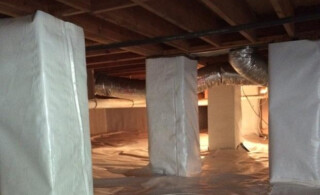
Shiyan / Adobe Stock
Slabs and crawl spaces can both make excellent choices for home foundations, depending on your needs. Slabs resist moisture but crack more easily when soil shifts. Crawl spaces work better on sloped properties but cost more. Slabs provide more durability, while crawl spaces hold up better in earthquake- and flood-prone areas. Read our comparison guide to learn the differences between slab and crawl space foundations to decide the best choice for your home.
On This Page:
- What’s the Difference Between Crawl Space and Slab Foundations?
- Side-by-Side Comparison
- Slab vs. Crawl Space: Which Is Better?
- Construction Cost
- Moisture Resilience
- Sloped Lots
- Maintenance Required
- Repair Cost
- Earthquake Resilience
- Energy Efficiency
- Pest Control
- Storage
- Resale Value
- Which Is Best for Your Home?
- Pros and Cons of Slab vs. Crawl Space
What’s the Difference Between Crawl Spaces and Slab Foundations?

Ursula Page / Adobe Stock
Before the 1970s, builders constructed homes with basements or crawl space foundations to protect the first floor from the ground. But then builders began pouring concrete slabs as another foundation alternative when they learned slabs decreased winter heating bills by 10% to 20%. Let’s examine the differences between slab and crawl space foundations.
Slab
A typical slab foundation contains a six-inch thick layer of poured concrete and footings (concrete columns) to anchor the foundation. Contractors pour footings two feet into the ground with a layer of sand, gravel, or rock for drainage purposes. Sometimes contractors use steel rods (rebar) with slabs to reinforce the weight of homes. Footings contain different styles and insulation options to fit environmental demands and the needs of each home.
- On-grade slab styles (monolithic): contain basic footings, a wire mesh for reinforcement and a layer of rock for drainage. Contractors pour the slab and footings together to form a single unit. These styles work best in non-freezing environments.
- Floating slabs: made with detached footings that don’t anchor into the ground, or no footings. Installers pour them separately from slabs. They contain rebar and wire mesh reinforcements and work best for sheds. Residential homes do not use floating slabs.
- Conventional foundations (T-shaped): contain heavy-duty reinforcements and footings that run deeper than the frost line. They extend past the home’s perimeter and into yards. These common foundations are used in environments prone to frost and contain stem walls that extend above the footings with a layer of concrete block between them.
- Raised slab foundations: midway between a slab and a crawl space. Contractors build a perimeter wall and footings for support. Then they fill the raised space with soil or rock for drainage and top it off with a layer of concrete. This style works well for extreme weather and flood-prone areas.
Crawl Space

Double_Vision / iStock / Getty Images Plus / Getty Images
A crawl space is an elevated foundation with footings for support typically raised 18 inches to 4 feet above the ground. Concrete or cinder blocks extend past the footings and close off unvented areas. Homeowners often layer the blocks with brick to improve the home’s aesthetics.
- Pier and beam foundations: contain concrete or wooden piers that support homes built 12 inches above the ground. These crawl space styles work well in areas prone to floods and earthquakes.
- Raised foundations: These pier-and-beam-style elevated structures support the home and form the crawl space. Using concrete or wooden piers, raised foundations elevate the structure and offer warmth because the subfloor doesn’t come into contact with the cold concrete used in slabs. This style of crawl space provides easy access to pipes and wires and works well in areas prone to floods and earthquakes.
Side-by-Side Comparison: Slab vs. Crawl Space Foundations
| Slab Foundation | Crawl Space | |
| Construction Cost | $4,500 – $12,000 | $8,000 – $21,000 |
| Moisture Resilience | Moisture-resistant | Contains moisture |
| Sloped Lots | Not recommended | Ideal |
| Maintenance Required | Low maintenance | Requires regular maintenance |
| Repair Cost |
$500 – $6,000 Difficult access |
$150 – $3,000 Easy to access |
| Earthquake Resilience | Poor | Good |
| Energy Efficiency | Excellent insulator | Poor insulator |
| Pest Control | Doesn’t harbor pests | Can harbor pests |
| Storage Availability | No capacity | Small to moderate capacity |
| Resale Value | Offers resale value where appropriate | Offers resale value where appropriate |
Which Is Better for Your Home: Slab or Crawl Space Foundations?
When choosing the right foundation for your home, compare all the slab and crawl space foundation qualities.
Construction Costs
Slab
When you call a local foundation contractor for slab foundation costs, expect to pay $4,500 to $12,000 for basic construction, but you can pay up to $21,000 for stem wall construction. Basic foundations that don’t require a lot of time to install can save money on labor costs.
Crawl Space
The basic price for a crawl space foundation runs between $8,000 to $21,000 for typical materials and installation. However, waterproofing and high-end insulation like spray foam insulation can cost $25,000. Since crawl spaces require more materials and time to build, labor costs typically cost more than slabs.
Most Affordable Construction Cost: Slab
Moisture Resistance
Slab
- Waterproofing barrier deters water from entering homes
- Resists moisture accumulation
- Not ideal for homes located in flood zones
Crawl Space
- High elevation and deeply anchored footings protect against rising water in hurricane and flood zones
- Waterproofing resists moisture and water
- Trapped, stagnant water and moisture can lead to mold and wood rot
Best Moisture Resistance: Slab
Sloped Lots
Slab
Virtually all pros do not recommend slabs for sloped lots due to the shallow footings and excavation needed for slab foundations.
Crawl Space
Building crawl space foundations on sloped land makes crawl spaces a better option to install buildings and footers into slopes without the need for large-scale excavation.
Best For Slopes: Crawl Space
Maintenance
Slab
- Concrete foundations do not require inspection or regular maintenance
Crawl space
- Crawl spaces require regular inspection and encapsulation to prevent mold, mildew and wood rot. They also require regular cleaning and rodent and insect inspection.
Easiest To Maintain: Slab
Cost of Repairs
Slab
Slab foundation repair costs can range from $500 to over $6,000. They can be costly due to several reasons, including:
- Difficulty accessing piping systems
- Difficulty getting under the block
- The need for multiple fixes; underpinnings and mud jacking can cost over $8,000
Crawl Space
Crawl space repairs cost $150 to $3,000. You can spot issues faster because they’re more visible and easier to access.
Complex repairs include:
- Flood damage reparation
- Damage to encapsulation systems which can run up to $15,000
- Mold and mildew growth and pest infestation when not maintained
Most Affordable To Repair: Crawl Space
Resistance to Earthquakes
Slab
Building a home on a concrete slab invites danger in an earthquake zone; slabs situated on the ground can crack easily when the ground shifts during an earthquake. Cracks can cause irreparable damage to homes.
Crawl Space
Crawl spaces provide a better option for homes located in earthquake zones due to their flexibility and resilience needed when the earth shifts during an earthquake.
Best For Earthquake Zones: Crawl Spaces
Energy Efficiency
Slab
A slab foundation helps to insulate a home by blocking air beneath the subfloor from entering a building. This can cut down heating and cooling consumption and costs. In comparison to crawl spaces, insulating the exterior of a slab cuts energy costs 10% to 20%.
Crawl Space
Even a well-insulated crawl space can’t rival a slab’s energy efficiency because outside air and wind can penetrate and circulate the subfloor and the home. This enables hot air to enter a house during the summer months and cool air and fierce winds to penetrate the home in winter.
Best Energy Efficiency: Slab
Pest Control
Slab
Most pests can’t fit inside the space needed to enter homes to nest and migrate. Plus, exterminators can treat the area for insect control before contractors pour the slab. However, termites can migrate into homes when professionals install exterior insulation, and the lower proximity to the ground makes access easier for small pests.
Crawl Space
- An exterminator can treat the ground for insect control before installation
- Rodents and insects that enter can gnaw insulations materials
- Crawl spaces provide easy access for pest inspection
- Termites and other pests need to work harder to enter a higher subfloor than a low slab
- Easy access provides opportunities for pests like squirrels to eat building materials and enter homes
Best Pest Deterrent: Slab
Storage
Slab
Slab foundations don’t offer room for storage. Since most slabs sit low to the ground, they don’t house enough space to fit belongings.
Crawl Space
Crawl spaces provide limited storage opportunities for small and moderate storage. Only store items in encapsulated crawl spaces. Otherwise, moisture infiltration and pests can enter and damage your storage items.
Best For Storage: Crawl Space
Resale Value
When building a new house, you want to make the best foundation decision now when hiring a foundation contractor to increase your ROI when you sell your home later. Both types of foundations could offer a good return on your investment, but first, consider your community and the buyers moving into it.
The following questions can help you guide your decision-making when choosing a foundation that produces the best ROI.
- Does your foundation style coordinate with the foundations in your community?
Maintaining a streamlined look with other homes in the community can improve your home’s value and appearance.
- Does your foundation use high-quality building materials in comparison to your neighbors?
Using high-quality materials will make your home look comparable to other homes in your community that use high-quality building options.
- Do new homebuyers in your neighborhood want energy-efficient features?
Energy efficiency matters to more buyers than ever these days. When crawl spaces cut down on heating and cooling costs, it makes your home economically appealing to buyers.
- Do you want to attract aging-in-place buyers?
Today, many builders construct homes with aging-in-place design elements to accommodate the retiring boomer generation. Concrete slabs at lower levels with a minimum of stairs could appeal to this generation compared to crawl spaces built at a higher elevation with more stairs to climb.
Best Resale Value: Tie
Which Is Best: Slab or Crawl Space Foundations?
When you’re looking for an affordable, energy-efficient foundation option that doesn’t require maintenance and you live in an area with high humidity that’s home to many outdoor pests, slab makes the best option. But when determining resale value, know what matters to buyers and your community.
But if your home stands on sloped land in a geographical area prone to floods and earthquakes, and you prefer easy access for potential repairs, and light storage, a crawl space is the best foundation for your home.
Pros and Cons of Slab vs. Crawl Space Foundations
| Slab | Crawl Space | |
| Pros |
|
|
|
Cons |
|
|
 Advantages of Modular Homes
Advantages of Modular Homes  Luxury House Plans
Luxury House Plans  Insulating a Crawl Space
Insulating a Crawl Space  Beach House Planning and Design
Beach House Planning and Design  How Long Will Your Home Be Under Construction?
How Long Will Your Home Be Under Construction? 

Are You Familiar With This Topic? Share Your Experience.